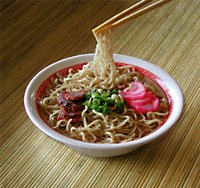Saimin
|
|
Likelikedriveinnsign.jpg
Washingtonsaimin.jpg
Saiminatzippys.jpg
Saimin is a food developed in and unique to Hawaii. Inspired by Japanese ramen, Chinese mein, and Filipino pancit, saimin was developed during Hawaii's plantation era. It is a soup dish of soft wheat egg noodles served in hot dashi: stock from Japanese bonito fish or shrimp. Unlike ramen, saimin noodles contain eggs and tend to crinkle when cooked. It is garnished with green onions, baby bok choy or Chinese mustard cabbage, kamaboko or steamed fish cake, char siu or Chinese barbecue pork, sliced luncheon meat (SPAM is the most popular choice) or Portuguese sausage, and nori or seaweed wafers among other additions. Japanese pot stickers, called gyoza, as well as Chinese won ton, are usually added for special occasions. A pan-fried version, primarily inspired by Filipino pancit is also popular, especially at carnivals, fair grounds, and catered parties.
| Contents |
Origins
Saimin is a contraction of two Chinese words 細麵: 細 (pinyin: xì, Cantonese: sai), meaning thin, and 麵 (miàn, mein), meaning noodle. Saimin is recognized as a traditional state dish in Hawaii, taking into consideration the various historic and cultural significances of its creation. The dish is composed of elements taken from each of the original sugarcane and pineapple plantation laborer ethnicities of the early 20th century: Chinese, Filipino, Japanese, Korean, Hawaiian, Portuguese.
As plantation laborers got home to their families in rented plantation lots or shacks, each family would begin cooking dinner. Sometimes, such meals became communal as a means of saving money. Every family would offer an ingredient they were able to spare. The Filipino family might have some extra green onions growing in their yard, the Portuguese family might have leftover sausage, the Hawaiian family's chickens might have laid a couple extra eggs, the Korean family might have bok choy unused from making kimchi. They would all throw their ingredients into the pot and share. It was through these communal meals that the Hawaiian Pidgin language was developed so they could all understand one another, borrowing words and phrases from each others' language and piecing them together. In some ways, saimin gave birth to Hawaii's becoming well known as a haven of multicultural harmony today.
Popularization
Saimin was first popularized as a fast food dish at Honolulu Stadium on King and Isenberg streets. As local residents watched Babe Ruth, Joe DiMaggio or their favorite high school football teams play on the field, fans rushed to the snack stands for a warm bag of boiled peanuts and a cup of hot saimin. For the first time, hot dogs and hamburgers were beat out at an American ballpark as the choice spectator snack.
The types of places in Hawaii where saimin is served today is a testament to the popularity of the dish and its importance to the local residents. Only in Hawaii is saimin served at all sporting venues alongside hot dogs and hamburgers, at popular national fast food chains like McDonald's and Jack in the Box as well as in the finest, high-end restaurants of the islands. A healthy alternative to most school meals, many public schools offer saimin as a regular option for students every day of the school year.
Historic Saimin Establishments
Several saimin establishments including saimin noodle factories and restaurants have become local landmarks in Hawaii and have attracted out of state visitors who have ventured off the traditional tourist beaten paths. Many of these establishments have been officially designated by the State of Hawaii as places of historic interest. Among such establishments are Likelike Drive Inn and Washington Saimin.
McDonald's Saimin
McDonald's, an American fast-food giant based in Oak Brook, Illinois, became alerted of the saimin phenomenon in the islands in the late 1960s. Maurice J. Sullivan, legendary Hawai‘i entrepreneur and owner of Foodland Super Market Limited, had purchased and opened the first McDonald's restaurant in Hawai‘i in 1968 at his flagship grocery store. He opened several more McDonald's franchises and for 12 straight months, McDonald's Hawai‘i became the highest grossing group of franchises in the world. Sullivan wanted to serve his favorite meal at his McDonald's restaurants, saimin, knowing all too well that his restaurants would boom with its introduction to the menu.
Sullivan invited executives from McDonald's corporation, including owner business tycoon Ray Kroc, for dinner at two family-owned, "hole-in-the-wall" saimin stands in Honolulu. They ate at Washington Saimin and Boulevard Saimin. That night, Sullivan convinced Kroc to expand McDonald's menu for the first time in its corporate history to include a local "ethnic" food. Researchers worked extensively with Washington Saimin to develop a recipe for McDonald's Hawaii. Sullivan secured deals with a local saimin noodle factory, fishcake supplier and a Japanese company, Aji-No-Moto, to manufacture a special soup base.
Saimin is today one of McDonald's Hawaii restaurant's most popular menu items. Later, Sullivan introduced a breakfast platter of Portuguese sausage, eggs and steamed white rice to his menu, capitalizing on another local food phenomenon.
Cultural Intrigue
Having become a unique cultural phenomenon, saimin is often the focus of study by scholars from colleges and universities worldwide. Only recently, saimin has been introduced to Las Vegas, Nevada; Los Angeles, California; San Francisco, California; Seattle, Washington; England and Japan.
Sources
- Aiko Hamura, Leila Fujimori, Honolulu Star-Bulletin, January 27, 2002 (http://starbulletin.com/2002/01/27/news/story10.html)
- Asian Noodles, Our Kitchen, Hormel Foods, 2004 (http://www.hormel.com/templates/knowledge/knowledge.asp?id=555&catitemid=45)
- Gambling on a Good Meal, Betty Shimabukuro, Honolulu Star-Bulletin, September 5, 2001 (http://starbulletin.com/2001/09/05/features/story1.html)
- Got Manapua, Kyle Tatsumoto and Keith Kamisugi, Nichi Bei Times, 2001 (http://www.keithpr.com/2jb/manapua.html)
- Noodlemania: Hawaii's melting pot is a bowl of saimin, Marnie Masuda, Maui Time Weekly, November 6, 2003 (http://www.mauitime.com/v07/v07iss19/feat.html)
- Saimin, Catherine Kekoa Enomoto, Honolulu Star-Bulletin, September 10, 1997 (http://starbulletin.com/97/09/10/features/story1.html)
- Shige's Saimin Stand, Lyle Galdera, KHNL, April 27, 2002 (http://www.khnl.com/Global/story.asp?S=760588)
- Joan Clarke, Local Food: What to Eat in Hawaii (http://search.barnesandnoble.com/booksearch/isbnInquiry.asp?userid=ZYw1r43NkR&isbn=0964335913&itm=23), Namkoong Publishing, 1997
- Rachel Laudan, Food of Paradise: Exploring Hawaii's Culinary Heritage (http://search.barnesandnoble.com/booksearch/isbnInquiry.asp?userid=ZYw1r43NkR&isbn=0824817788&itm=5), University of Hawaii Press, 1996


